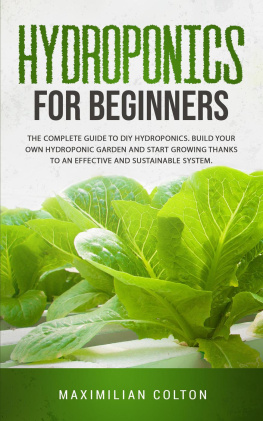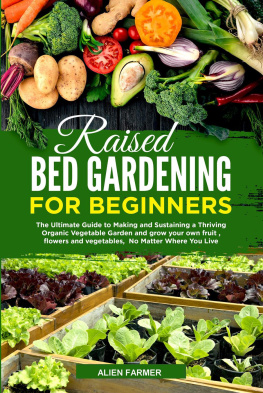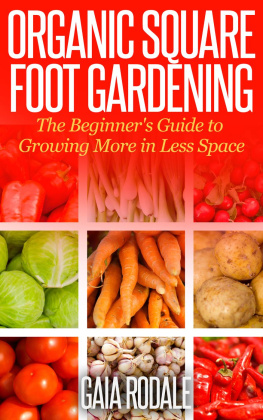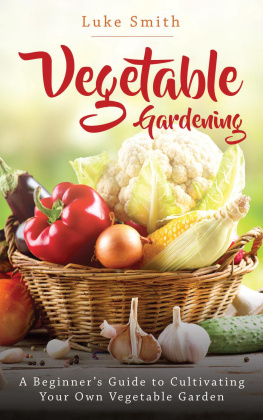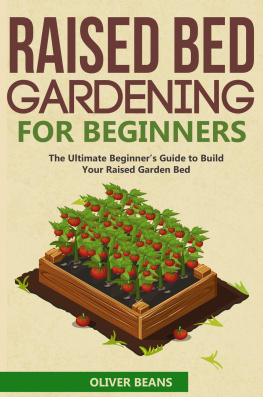Raised Bed Gardening
Maximilian Colton
Published by Maximilian Colton, 2021.
While every precaution has been taken in the preparation of this book, the publisher assumes no responsibility for errors or omissions, or for damages resulting from the use of the information contained herein.
RAISED BED GARDENING
First edition. March 7, 2021.
Copyright 2021 Maximilian Colton.
Written by Maximilian Colton.
10 9 8 7 6 5 4 3 2 1
Table of Contents
C ongratulations on purchasing Raised Bed Gardening for Beginners, and thank you for doing so. Raised bed gardening refers to an easy way to produce homegrown vegetables and small fruits. Raised bed gardening doesnt require a large space compared to traditional in-ground gardening. Raised beds can be created by molding soil somewhere on your property and containing it with a frame to prevent soil loss. Raised bed gardening is essential because it improves the condition for plants by lifting their foundation above poor soil. Also, the raised bed depletes dampness and allows air to move around the plant root. You need a raised bed garden if your local soil is not good and you need better drainage so you can grow crops sensitive to wet conditions. Additionally, if you want to plant in an area inclined to flooding, a raised bed garden is required.
This book will enlighten readers on how to create and sustain an elaborate raised bed garden in any area. What to plant in a raised garden is also crucial; it is paramount to choose both vegetables you and your family prefer to eat and that grow well in your area. Where to plant is also very important; it is essential to plant vegetables in an accessible space. If you do not have much space, it is advisable to plant vegetables that can be grown vertically on trellises.
Some plants thrive better in some areas, so it is important to become acquainted with the vegetable timeframe in your area. In areas where farming was dominant before it became a residential area, some diseases may be common. Ensure you research and find a way to prevent them before starting your raised bed garden. Planting in a raised bed garden is very similar to planting in a conventional nursery bed. Seeds can be planted in columns or bunches, contingent upon the size and state of the garden bed. Planting transplants instead of seeds gives plants a head start on the growing season. Normally, smaller plants are better adjusted to the bounds of a compartment garden.
WHY CHOOSE RAISED BED GARDENING
R aised bed gardening can be described as a convenient and easy way to produce homegrown vegetables and small fruits. Compared to traditional in-ground gardening where a large space is required, raised bed gardening is an alternative for people who have limited garden space, poor or rocky soil, insufficient soil drainage, or physical impediments. Raising a bed garden is not dependent on family size or cultivating experience. Raised beds afford homeowners the chance to grow vegetables themselves.
Raised bed cultivating is not much different from traditional in-ground gardening. For a long time, ranchers and nursery workers have mounded soil up to grow plants. Raised bed planting is interesting in that the dirt level is higher than the encompassing soil and encased with materials to keep soil from spilling out. The contained soil is framed into planting beds three to four feet wide, small enough that an individual can maintain it without venturing onto and disturbing the planting area.
Also, a raised bed can simply be created by mounding soil somewhere on your property, but unless the beds will be placed within a large-scale garden plot, it is better to contain the soil inside a frame to help prevent soil loss. Raised-bed frames can be constructed using different kinds of materials such as brick, concrete, plastic, or even sandbags.
Wood frames are simple to construct, easy to install (or reinstall if need be), food-safe, and biodegradable. They are raised a few inches or more above the soil level and should be narrow enough to reach across by hand. Plants can be grown in groups in a bed with walkways on either side. The dirt does not get compacted since it is never walked on. Growing plants in a single record, or column crops, began with the utilization of a pony and furrow to grow crops on a large scale.
However, for a large garden, multiple beds of mounded soil are adequate to achieve desired results. Ensure plenty of mulch is used on the earth to hold it in place during rains. Raised beds can also be referred to as freestanding garden beds because they are constructed above the natural terrain. Soil that is not properly aerated because of compaction or poor drainage may cause an issue. Soil quality issues are common in urban and rural settings where topsoil and vegetation have been removed or the level changed during development.
Raised bed gardens improve growing conditions for plants by lifting their foundations above poor soil. The soil in the beds can be corrected to provide a better growing medium for plants, and even for plants that would not naturally thrive there. Soil found in raised beds heats quicker in spring and is less apt to be invaded by certain grasses and tree roots. Additionally, the height of raised beds may make it easier to maintain.
The raised beds are desirable, even though a lot of resources might be utilized in their development. Planting in raised beds permits excess dampness to deplete out of the dirt and allows air to move around the plant roots, decreasing the potential for decay. Raised beds are often utilized in California and can make planting simpler for you. The least complex raised bed is soil mounded between two equal wrinkles or a water system trench. The wrinkles likewise give walking space between plant columns. These beds are made of mounded soil 20 to 60 inches (0.5 to 1.5 m) wide from one end to the other. The real measurements will rely upon the soil, water system strategies, social practices, and what is to be planted. Typical width is 30 inches (0.75 m): a solitary line of cabbage or beans, or two lines of carrots or beets, can be planted in a bed this wide.
For spreading plants (for example, tomatoes and squash), a 48 to 60 inch (1.2-to 1.5-m) bed is optimal. If the nursery inclines, beds should run north and south with the goal that the two sides will get equivalent daylightthis is especially important for winter gardens. Raised beds might be strengthened by a wooden casing, especially if the soil is substantial or ineffectively depleted. Raised beds with wooden sides offer numerous favorable circumstances other than improved waste. If gophers are an issue, a wire can be put under the bed before it is loaded up with soil.


